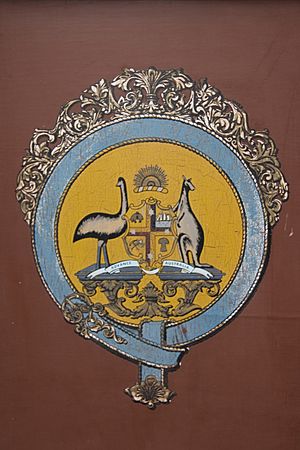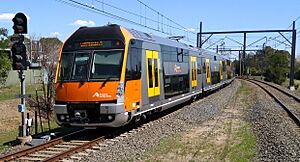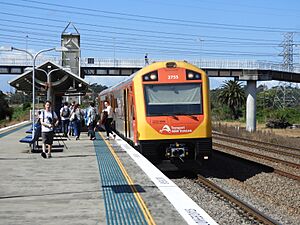Rail transport in New South Wales facts for kids
The Australian state of New South Wales has a huge network of railway lines. These lines were super important for the state to grow and develop. Most of these railways were built and run by the government. But there were also some private railways, and a few of them are still running today!
Contents
Who Runs the Trains?
For a long time, the railways in New South Wales were run by government groups. Their names changed a few times, like the New South Wales Government Railways and the State Rail Authority.
Today, three main government groups look after the heavy rail lines in New South Wales:
- Transport Asset Holding Entity: This group owns the railway tracks and land.
- Sydney Trains: They manage the tracks, keep them in good shape, and run the trains in Sydney's suburbs.
- NSW TrainLink: They run the trains that travel to regional areas outside of Sydney.
Since 2003, some parts of the railway network, like freight lines (for carrying goods) and coal lines, have been run by private companies.
A Journey Through Time: Railway History
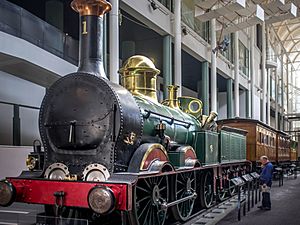
The very first railway in Australia opened in New South Wales on December 10, 1831. It was in Newcastle and was owned by a private company. This railway was used to carry coal from a mine. It was a special "gravitational railway" where gravity helped move the coal down a slope!
People thought a lot about where to build new train lines. They explored and planned many routes, especially for crossing the tough Blue Mountains.
The first public train line in New South Wales opened in 1855. It went from Sydney to Parramatta Junction (which is now in Granville). The first stations were Sydney, Newtown, Ashfield, Burwood, Homebush, and Parramatta.
There was a bit of a mix-up with the size of the tracks, called the "rail gauge." After some changes, New South Wales decided to use the "standard gauge" (which is 1435mm wide). All new lines built after that used this size.
The Main Southern line was built in steps from Parramatta Junction all the way to the border with Victoria at Albury between 1855 and 1881. In 1962, a standard gauge line finally connected Albury to Melbourne, completing the Sydney–Melbourne railway.
Train lines were built to connect Sydney and Newcastle to the farming areas inland. The Main Western line went from Parramatta Junction to the north-west, reaching Bourke by 1885. The Main North line went from Newcastle to the Queensland border by 1888. Sydney and Newcastle were connected by rail in 1889.
A very important person in the history of New South Wales railways was John Whitton. He was the Engineer-in-Charge for the railways from 1856 to 1899 and is often called the "Father of New South Wales railways."
The North Coast line, which is a shorter way to get from Sydney to Brisbane, started being built in 1905 and finished in 1932. The last main line to be completed was to Broken Hill in 1927. This line connected with the South Australian railways. In 1970, the tracks in South Australia were also made standard gauge, creating a continuous line from Sydney to Perth!
Sydney's City Train Network
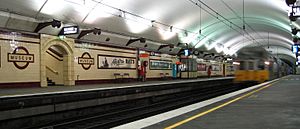
The first company to start building a railway in Sydney was the Sydney Railway Company in 1849. They wanted to build a line from Sydney to Parramatta.
There were some problems at the start. Engineers changed, land was expensive, and there wasn't enough money or workers, partly because of a gold rush! Eventually, the government took over the railway project.
The first line opened on September 26, 1855, from Sydney to Parramatta Junction. The Sydney station was near where the current Central station is today. This line is still the main part of Sydney's suburban train system.
Sydney's train network grew from these early lines. From 1926, many of the city's train lines were made electric. In 1932, when the Sydney Harbour Bridge was finished, new lines opened connecting the city centre to the North Shore. The City Circle line, which goes in a loop around the city, was completed in 1956. Newer lines have been added over the years, like the line to Sydney Airport in 2000 and the South West Rail Link in 2015.
Some older branch lines, like the one from Clyde to Carlingford, are now being changed into light rail lines.
The Main Southern Line
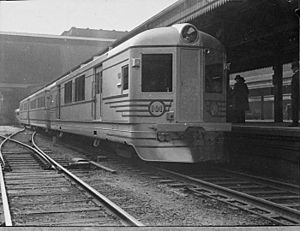
The train line from Parramatta Junction was extended to Liverpool in 1856. It then kept going south, reaching Campbelltown in 1858, Goulburn in 1869, Wagga Wagga in 1879, and finally Albury in 1881.
A branch line was also built from Goulburn to Queanbeyan (1885) and Cooma (1887). A short line from Queanbeyan connected to Canberra in 1914.
The Main Western Line
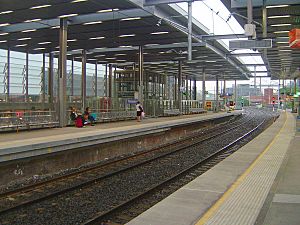
The Main Western line was extended from Granville to Parramatta and Blacktown in 1860, and then to Penrith in 1863. Building this line over the Blue Mountains was very hard! They used special "zig zag" railways at Lapstone (1867) and Lithgow (1869) to climb the steep hills. These zig zags were later replaced by tunnels. The line continued to Bathurst (1876), Orange (1877), and Bourke (1885).
The Broken Hill Line
A section of the line to Broken Hill was built from Orange to Parkes (1893) and further west. A separate standard gauge line was also opened from Menindee to Broken Hill in 1919. This line met a narrower 1067mm gauge line called the Silverton Tramway.
The last part of the line between Trida and Broken Hill was finished in 1927. In 1969, the line from Broken Hill to Port Pirie in South Australia was also made standard gauge. This completed the standard gauge link all the way from Sydney to Perth!
The Illawarra Line
The Illawarra line was opened in steps, heading south from Sydney. It reached Wollongong in 1887 and Bomaderry (near Nowra) in 1893. A branch line from Sydenham to Bankstown (1909) later became part of Sydney's Bankstown Line.
The Main North Line
The first part of the Main North line was built in the Hunter Valley in 1857. It was extended north to Wallangarra on the Queensland border by 1888. Here, it connected with Queensland's railway line, but Queensland used a different track size. The final section connecting Strathfield (Sydney) and Newcastle was finished in 1889 with the opening of the Hawkesbury River railway bridge.
The North Coast Line
The North Coast railway line was built between 1905 and 1932. When it was finished, it offered a faster way to travel up the eastern coast than the Main North line. The hardest part to build was crossing the Clarence River at Grafton. This was completed in 1932 when the Grafton Bridge opened.
Light Rail Systems
Besides the big heavy trains, there are also light rail systems in Sydney and Newcastle. These are like modern trams.
In Sydney, the Inner West Light Rail uses parts of an old goods train line. Most of the old Carlingford train line is being turned into part of the Parramatta Light Rail. The CBD and Southeast Light Rail in Sydney was built completely new.
In Newcastle, part of the old heavy train line was removed and replaced by the Newcastle Light Rail.
There's also a special old heavy rail line that runs into the Royal National Park. It's now run by the Sydney Tramway Museum for fun rides.
Private Railways
Some private train lines were built to connect coal mines in the South Maitland area to the main railway network. Many of these joined together to form the South Maitland Railway.
A narrow gauge railway was built by South Australia from Port Pirie to Broken Hill in 1888. This was to serve the huge silver and lead mines there. Since the New South Wales government didn't allow South Australia's trains to cross the border, the last 30 km were built by a private company called the Silverton Tramway. In 1970, this line was replaced by a standard gauge government line, completing the standard train link across Australia from Sydney to Perth.
The Byron Bay Train is a special passenger service in Byron Bay. It uses an old train car that has been changed to run on solar power!
Many other private railways were built in New South Wales to serve coal mines, steel works (like the one at Port Kembla), and quarries, especially in the early 1900s.
Even though the light rail and Sydney Metro networks are owned by the public, private companies are hired to run the trains on these lines.
Trains from Other States
Sometimes, parts of New South Wales are closer to other states than to Sydney. Because of this, train lines from other states, which sometimes use different track sizes, have extended a short way into New South Wales.
For example:
- The Silverton Tramway from South Australia to Broken Hill used a 1067mm (3ft 6in) gauge.
- Queensland's South Coast line came into Tweed Heads and also used a 1067mm (3ft 6in) gauge. This line ran from 1903 to 1961.
- A short part of Queensland's 1067mm (3ft 6in) gauge line still exists just over the border at Wallangarra.
The Deniliquin line was the first 1600mm (5ft 3in) gauge line from Victoria to extend into New South Wales in 1876. Later, other Victorian lines also extended into New South Wales, like the Tocumwal line in 1908.
Today, only the Deniliquin and Oaklands lines from Victoria are still open for trains in New South Wales.


